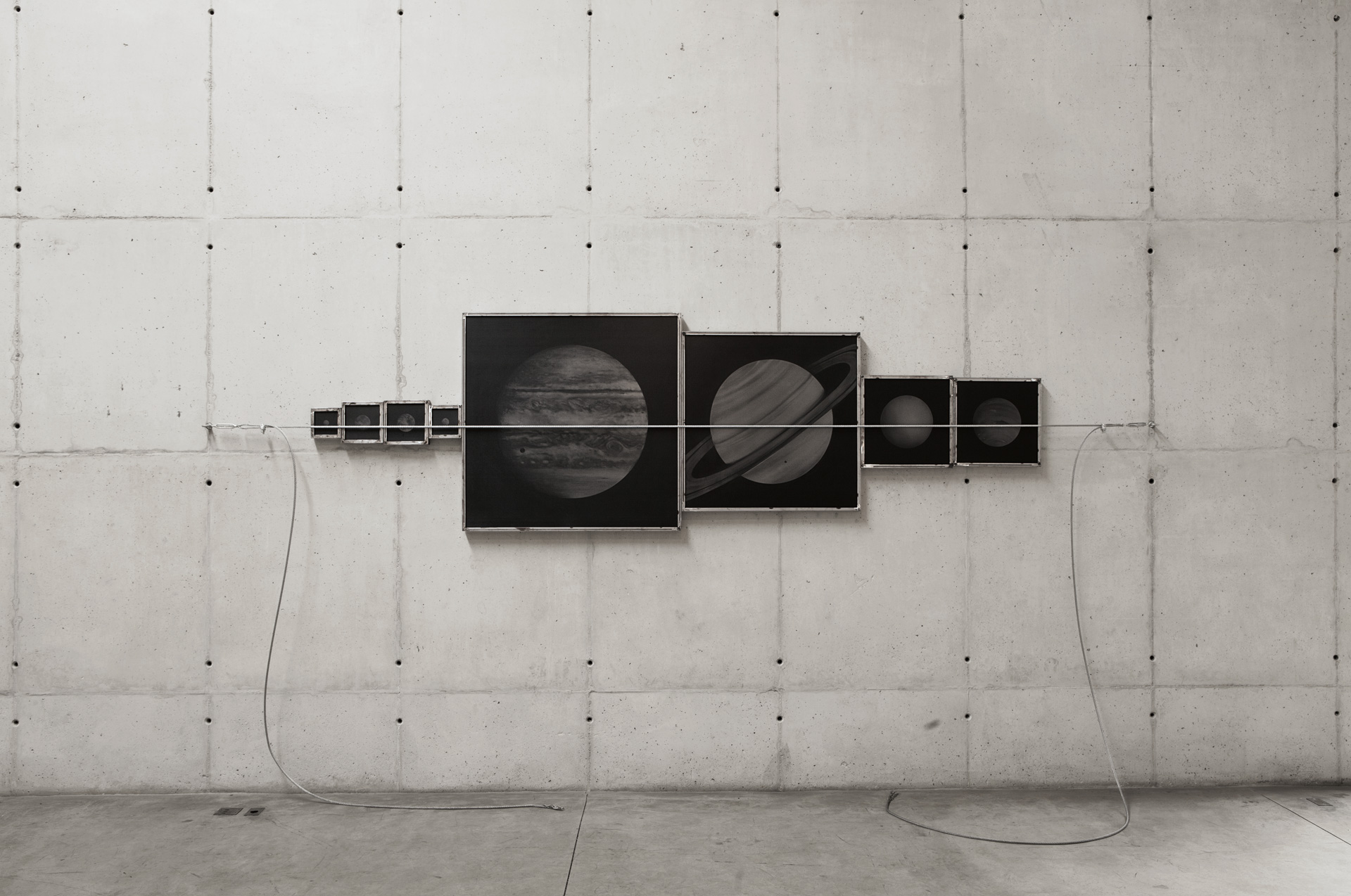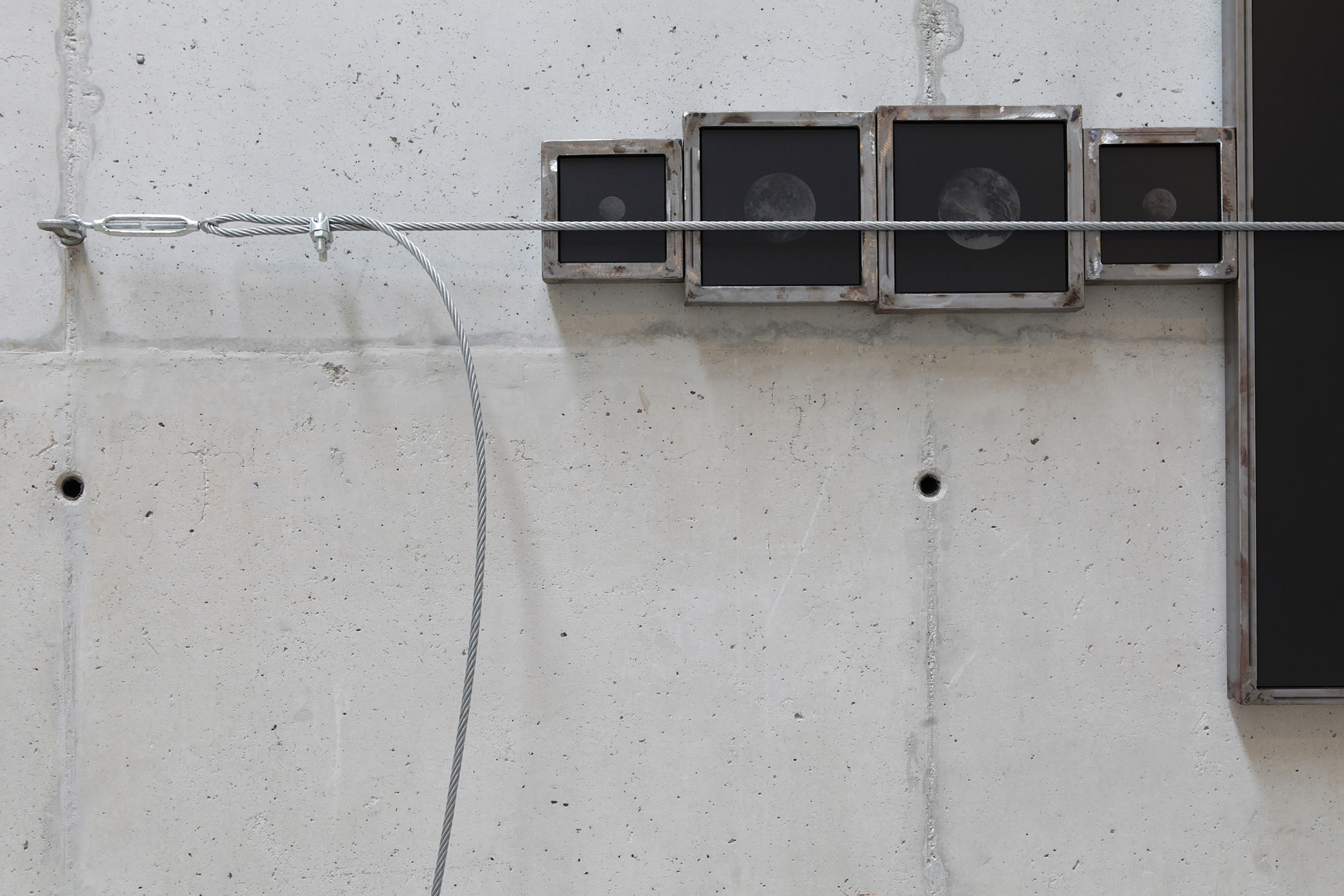Atlas
graphite drawing on PVC board, iron, and stain wire
250 x 500 x 70 cm
2011

Atlas, in Greek mythology, was a titan who belonged to the divine generation of the disproportionate beings, violent, monstrous – incarnation of the wild forces of the initial cataclysms, with which the earth was able to receive the life of the humans.
Atlas, like other titans - forces of chaos and disorder - intended to reach the supreme power, for what he attacked the Olympus and fiercely fought Zeus and order allies, as Cosmos. Zeus, triumphant, punished his enemies – slaves of the matter and of the senses, releasing them into Hades, so they would never scape from there. Reserved to Atlas, however, a special sentence: put him to sustain, in his shoulder and forever, the sky.
The 8 draws of planets from the solar system that set the work ATLAS are reproduced in its proportions among themselves and having an iron cable as support element of the group keeping it next to the gallery’s wall, referring to the condemnation of the Greek Titan, having all the universe to keep in balance.
Atlas, like other titans - forces of chaos and disorder - intended to reach the supreme power, for what he attacked the Olympus and fiercely fought Zeus and order allies, as Cosmos. Zeus, triumphant, punished his enemies – slaves of the matter and of the senses, releasing them into Hades, so they would never scape from there. Reserved to Atlas, however, a special sentence: put him to sustain, in his shoulder and forever, the sky.
The 8 draws of planets from the solar system that set the work ATLAS are reproduced in its proportions among themselves and having an iron cable as support element of the group keeping it next to the gallery’s wall, referring to the condemnation of the Greek Titan, having all the universe to keep in balance.





Atlas
desenho à grafite sobre PVC expandido, ferro e cabo de aço
250 x 500 x 70 cm
2011
Atlas, na mitologia grega, era um titã que pertencia à geração divina dos seres desproporcionados, violentos, monstruosos - encarnação das forças selvagens da natureza nascente, dos cataclismas iniciais, com que a terra se arrumava para poder receber, num regaço mais acalmado, a vida e a sua cúpula consciente: os humanos.
Atlas, com outros titãs, forças do caos e da desordem, pretenderam alcançar o poder supremo, pelo que atacaram o Olimpo e combateram ferozmente Zeus e aliados da ordem, do Cosmos. Zeus, triunfante, castigou seus inimigos - escravos da matéria e dos sentidos, lançando-os no Hades, para que de lá nunca fugissem. Reservou para Atlas, porém, uma pena especial: pô-lo a sustentar, nos ombros e para sempre, o céu.
Os 8 desenhos de planetas do sistema solar que compõem a obra ATLAS são reproduzidos em sua proporção entre si e tendo um cabo de aço como elemento de sustentação do conjunto junto à parede da galeria, remetendo assim à condenação do titã grego, tendo todo o universo para manter em equilíbrio.
Atlas, com outros titãs, forças do caos e da desordem, pretenderam alcançar o poder supremo, pelo que atacaram o Olimpo e combateram ferozmente Zeus e aliados da ordem, do Cosmos. Zeus, triunfante, castigou seus inimigos - escravos da matéria e dos sentidos, lançando-os no Hades, para que de lá nunca fugissem. Reservou para Atlas, porém, uma pena especial: pô-lo a sustentar, nos ombros e para sempre, o céu.
Os 8 desenhos de planetas do sistema solar que compõem a obra ATLAS são reproduzidos em sua proporção entre si e tendo um cabo de aço como elemento de sustentação do conjunto junto à parede da galeria, remetendo assim à condenação do titã grego, tendo todo o universo para manter em equilíbrio.